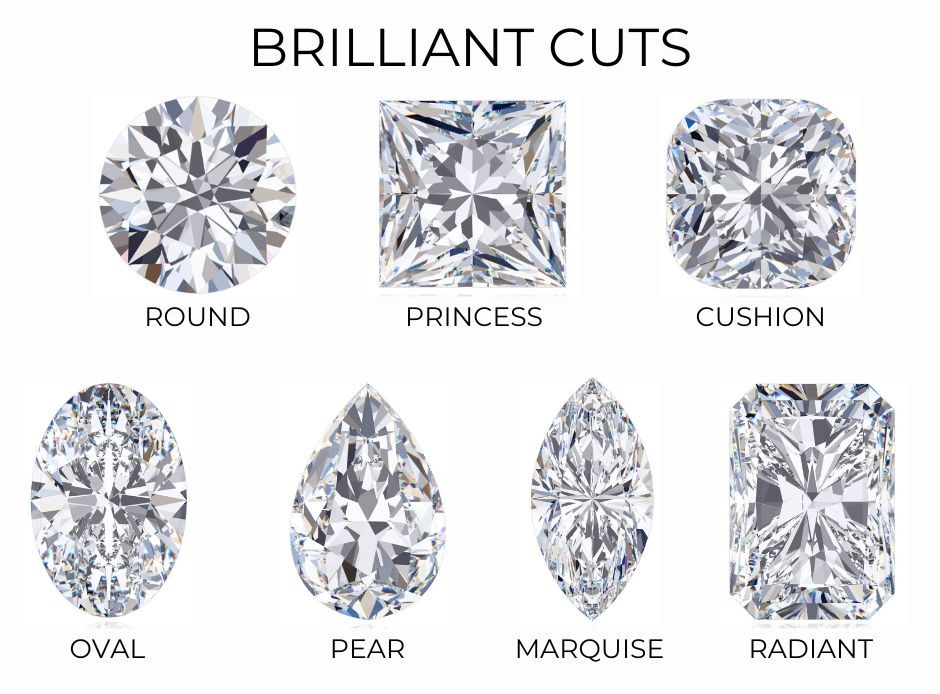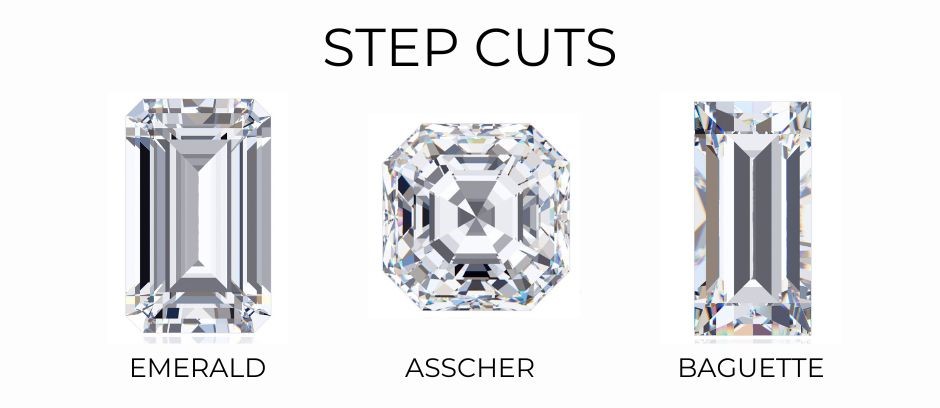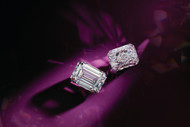Nov 1st 2022
Brilliant Cut vs. Step Cut Diamonds: What’s the Difference?
The holidays are quickly approaching, and you’re thinking about surprising your special someone with a spectacular diamond engagement ring. You’ve started doing some subtle research and realized that some rings boast more sparkle than others. Why? It depends on the cut of the diamond! Brilliant cut and step cut diamonds are most popular, and we’re here to tell you about both!
What is a Brilliant Cut Diamond?
A brilliant cut diamond features facets (aka flat, polished surfaces) that are arranged to enhance the stone’s sparkle/brilliance. At quick glance, these triangular and kite-shaped pieces appear to be placed haphazardly throughout the stone. But they’re actually strategically arranged.
You can identify brilliant cut diamonds by their sparkle as well as their shape. With the exception of princess-cut diamonds, which are square-shaped, most brilliant cut diamonds have round or elongated shapes.
Popular Brilliant Cut Diamond Shapes
● Round cut: This diamond shape is most popular among couples. In fact, The Knot 2019 Jewelry & Engagement Study found that nearly 50% of pairs chose a round cut center stone for an engagement ring. Why? Maybe it’s because this shape contains nearly 60 facets!
● Princess cut: For a modern look, this cut boasts a square shape, and it sparkles almost as much as round cut diamonds. According to the above study, princess cuts are among the most popular stone shapes for engagement rings. Roughly 15% of couples picked them.
● Cushion cut: A square-shaped stone, like the princess cut, but with rounded corners that looks like a cushion or pillow. This shape is almost 200 years old and may also be referred to as an “antique square” or “modified cushion.”
● Oval cut: This shape is essentially an elongated version of a round cut diamond, so it offers a similar level of sparkle. It also creates the appearance of a larger gem and will therefore make your partner’s finger look longer and slimmer.
● Pear cut: This contemporary cut resembles a teardrop. Similar to oval-shaped diamonds, it also creates the illusion of a longer finger.
● Marquise cut: Want an easy way to remember this shape? It’s basically a pear cut diamond with a second pointed tip. This vintage style has been reportedly growing in popularity lately. And given its large surface area, it often looks bigger than its actual size!
● Radiant cut: This cut is a newer style, as it wasn’t introduced until the 1970s. Its shape is sometimes compared to an emerald cut, but it has much more sparkle! Not familiar with emerald cuts? We’ll explain more later!

Should You Buy a Brilliant Cut Diamond?
Pros:
● If your partner loves bling, you can’t go wrong with a brilliant cut! Round-shaped diamonds specifically work well in a variety of engagement ring settings and offer a classic look.
● Due to their amazing sparkle, these diamonds often hide imperfections and hints of unwanted color. However, this varies depending on the gem shape.
● They can create a bigger, bolder look on one’s finger!
Cons:
● Since the placement of each facet requires much precision, brilliant cut diamonds are typically more expensive than step cut stones.
What is a Step Cut Diamond?
Here’s a trick for remembering this type of diamond: Its facets look like a series of steps! You’ll typically see step cut diamonds in rectangular or square shapes, and their facets are placed in parallel rows, creating long, clean lines. While sparkle is important for brilliant cut diamonds, clarity is key when choosing step cuts.
Popular Step Cut Diamond Shapes
● Emerald cut: This cut has a rectangular shape with trimmed corners, so it essentially looks like a stretched octagon. Its long, large facets appear staggered, creating a stunning “hall-of-mirrors” effect.
● Asscher cut: You could say this shape is a cousin to the emerald cut. Asscher cuts also offer a hall-of-mirrors effect, but these facets are X-shaped and therefore resemble a unique windmill design.
● Baguette cut: This shape is also similar to an emerald cut, but it features pointed corners and fewer facets. Tip: Baguette cut diamonds are typically used as side stones to further enhance a center stone in an engagement ring.

Should You Buy a Step Cut Diamond?
Pros:
● Step cuts tend to be more budget-friendly because less of the natural diamond is discarded when fashioning the stone into a gem-quality piece.
● Given their sleek appearance, these diamonds are perfect for vintage jewelry lovers!
● Step cut diamonds can be placed in a range of engagement ring settings, but they look particularly fantastic in Art Deco designs.
Cons:
● Step cut gems don’t sparkle quite as brightly as brilliant cut diamonds, so keep your partner’s tastes in mind.
● These facets appear larger, making it easier to spot imperfections and touches of color. That’s why it’s important to focus on clarity when choosing your step cut stone.
Have a question? We can help!
Gage Diamonds is Chicago's premier jewelry showroom and online retailer of engagement rings, wedding bands, and fine jewelry. We offer a selection of dazzling handpicked diamonds, including brilliant and step cut diamonds.
We’re committed to helping you find the ring of your dreams. For inspiration, browse our website or set up an appointment with a member of our trusted staff at our in-person showroom.
We offer no-credit-needed financing – feel free to apply and get your approval within 24 hours!
Pay over time, because love shouldn’t wait.
 VISIT OUR SHOWROOM
VISIT OUR SHOWROOM Reviews on Google!
Reviews on Google!





